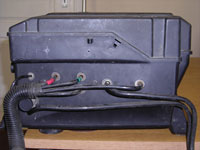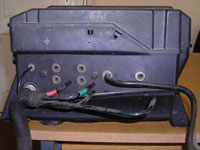|
Air Suspension Manual Inflation Valve |
|
|
The majority of the Range Rover air suspension components are connected via 6mm flexible air lines, so providing your air springs are not damages you can simply disconnect four of these air lines from the main valve block which is located under the bonnet and connect them directly to these independent filler valves. This will then allow you to manually re-inflate your air springs using any form of compressed air such as the garage forecourt airline or even a portable pump. Click the link below for further details& pricing: Before attempting any work on the air suspension system it is important to note that the system is still active for up to an hour after turning off the engine your range rover. We therefore advise that you disconnect the battery prior to working on the vehicle. Note: Always make sure you have your 4 digit EKA code (emergency key access code) before disconnecting the vehicle main battery.
|
|
 |
Push-fit connections To remove an airline from a push-fit connection - Using a flat blade screwdriver or your fingertip lightly push inwards on the collar surrounding the airline while at the same time lightly pulling outwards on the airline. The collars on these new valves are black in colour. To insert an airline into a push-fit connection - make sure the airline is clean and not pinched, scored or deformed. Push the airline inwards approximately 12mm (you will feel a slight click). Pinched, scored or deformed airlines should be cut clean at 90 degrees with a suitable blade or Stanley knife. |
 |
This image shows the location of your EAS air suspension housing. |
 |
This
shows the side view of the EAS air suspension housing.
There is no need for you to remove the housing from the vehicle, we have only done this for ease of photography.
|
 |
Here
we have removed 4 airlines, one running to each of the air springs, you
may notice some of them have coloured bands around them.
Don't worry about the larger airline we have disconnected on the far right of this image as again, we have only done this for ease of photography. |
 |
This
diagram shows which airline feeds which corned of the vehicle.
You may notice that the valves are numbers on the side of the valve block. No 1 - Rear passenger side No2 - Rear Driver side No 3 - Front passenger side No 4 - Front driver side |
 |
This image shows the new valves fitted to each of the four airlines. |
|
If
manual re-inflation of the air suspension system is required, it is
important to disable the factory electronic ECU system first. The
quickest way to achieve this on a P38 Range Rover 1994-2002 is to remove
the delay timer which is situated under the front passenger seat, it
looks like a black relay and should be the only one under the seat,
please check the Part No: ANR4387 or ANR4652 before removing it.
Please note: Classic Range Rovers 1992-1995 have a disable switch under the rear of the drivers
seat. When the EAS Electronic Air Suspension is disabled there is no control over the height. A
height of 450mm measured from the centre of the road wheel to the bottom
of the wheel arch equates to a standard setting. Check for leaks
regularly as the onboard compressor will not top up the system. As a rough guide 50psi to 55psi (just under 4 bar pressure) is the correct pressure for standard height. DO
NOT OVER INFLATE THE AIR SPRING BAGS
- you will be surprised how quickly the vehicle will rise up especially
using a garage compressor. Over inflation will damage your air spring
bags. They will pop just like a balloon if over inflated. Any questions you can email me david@tawpark4x4.com or call: 01271 321001 and I'll try to help. |
|